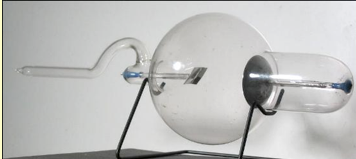The Focus Tube (1896) “Jackson’s”
Ref. B1








This type of tube, introduced in 1896, a few months after Röntgen’s discovery of X-rays, is commonly known as the JACKSON TUBE or Focus Tube. In the above pictures, the tube is seen from different angles. The anti-cathode is a very thin square plate of pure platinum. Etched on the back-side of the aluminium cathode are the maker’s name and address “Newton and Co., 3 Fleet Street, London”. The external connections are looped platinum wires.
Hereafter is an early description of this tube :
“….The most important step in the evolution of X-ray tubes is marked by what is now commonly called the focus tube. The credit of its inception is given to three different investigators, namely, Prof. Röntgen himself, Prof. Elihu Thomson who is said to have worked with a focus tube in January, 1896, and Mr. Herbert Jackson, of King’s College, London, who, at any rate was the first to use it publicly…The design of the focus tube obviates the defects of cathode tubes, in so far as the point which the cathode rays strike is no longer the glass of the tube, but a suitable metal (platinum) which may become white hot without endangering the tube itself. Moreover, as the cathode is of concave shape, the cathode rays converge to a focus, so that the source of X-rays becomes limited in size and so permits of superior definition in the resulting radiograms.
….. In later types, particularly of continental origin, the tube is provided with a separate anode which may at will be connected to the anticathode. Several forms of “multi-anodal” tubes are illustrated.”